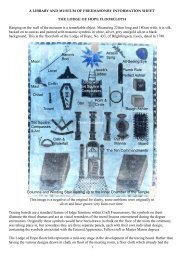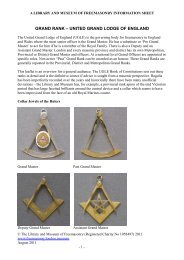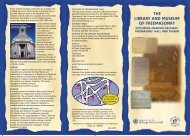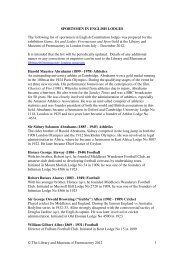FREEMASONS AND THE ROYAL SOCIETY Alphabetical List of ...
FREEMASONS AND THE ROYAL SOCIETY Alphabetical List of ...
FREEMASONS AND THE ROYAL SOCIETY Alphabetical List of ...
Create successful ePaper yourself
Turn your PDF publications into a flip-book with our unique Google optimized e-Paper software.
Fellows <strong>of</strong> the Royal Society who are or were Freemasons, listed alphabetically<br />
K<br />
Kater, Henry, FRS [15 Dec 1814] (16 Apr 1777–26 Apr 1835), geodesist and metrologist.<br />
Born in Bristol, son <strong>of</strong> Henry Kater, sugar baker <strong>of</strong> German descent. Intended for the law, articled to Bristol<br />
Attorney, 24 Sep 1794, but on his father’s death 5 months later allowed him then to leave the <strong>of</strong>fice and start once<br />
more his mathematical studies, aiming to begin a military career. Purchased, 25 Apr 1799, commn as Ensign, 12 th<br />
Foot, and sailed to join regt in Madras. For many years helped William LamBton, subaltern in 33 rd Foot, surveying<br />
country between the Malabar and Coromandel coasts for Madras Govt. This laid foundation for great trigonometrical<br />
survey <strong>of</strong> India under George Everest. Kater promoted Lt, 3 Nov 1803. During his time in India, he laid the basis for<br />
his subsequent career, devising improvements to scientific instruments, but returned to England owing to ioll health.<br />
Promoted Capt, 62 nd Foot, 13 Oct 1808, without purchase. Underwent further training in senior dept, Royal Military<br />
Coll, High Wycombe, 1806–10 and joined 2 nd Bt <strong>of</strong> his Regt in Jersey.<br />
Put on half pay 1814, ending his military career. The RS was the focus <strong>of</strong> much <strong>of</strong> his scientific work during the<br />
remainder <strong>of</strong> his life and as a result he met many leading contemporary scientists. He served on RS’s Council, Treas<br />
1827–30 and once as V-P. Served on committee set up to determine length <strong>of</strong> a pendulum beating 2nds in latitude <strong>of</strong><br />
London to provide a basis for a standard <strong>of</strong> length, devising a reversible pendulum with knife-edge supports towards<br />
each end, conducting experiments and measurements, for which he received the Socy’s Copley Medal, 1817. Again<br />
his entry in ODNB proves a mine <strong>of</strong> useful information about his later career.<br />
Married 31 May 1810 and had 3 children including 2 boys, the younger <strong>of</strong> whom, Edward Kater (1816–1866),<br />
published in 1840 the result <strong>of</strong> his father’s investigations into clock escapement mechanism, as a result <strong>of</strong> which he<br />
was elected FRS 19 Nov that year.<br />
Died at his home, 12 York Gate, Regent’s Park, London, and buried with his wife and dau in the recently built<br />
church <strong>of</strong> St Mary-in-the-Castle, Silverdale, Hastings.<br />
Although his entry in ODNB asserts that ‘at the beginning <strong>of</strong> 1799 he was made a freemason’, it had proved<br />
impossible to find any reference to support this contention in the records held at FMH, 60 Great Queen Street, so his<br />
membership <strong>of</strong> the Craft is currently unproven and likely to remain so. He is, however, included in case fresh<br />
evidence <strong>of</strong> his becoming a Freemason emerges later.<br />
Kearton, (Christopher) Frank, OBE, FRS [16 Mar 1961], later [1966] Sir Frank Kearton, then [5 Feb 1970]<br />
Baron Kearton <strong>of</strong> Whitchurch [Life Peer] (17 Feb 1911–2 Jul 1992), Scientist and industrialist, <strong>of</strong> 31 Redwing<br />
Lane, Norton, Stockton-on-Tees, Co Durham.<br />
Born in Cheshire and brought up in Tunstall. Graduated from St John’s Coll, Oxford with 1 st Cl honours in natural<br />
science in 1933. Joined the Billingham division <strong>of</strong> Imperial Chemical Industries where he worked on chemical<br />
engineering research. Seconded in 1941 to the Br atomic bomb project. In 1945, Kearton joined Courtaulds,<br />
becoming Chmn in 1962, during which time he transformed Courtaulds into a major interNatl co based on its research<br />
and development in man-made fibres. Served on several govt advisory bodies including the Industrial Reorganisation<br />
Corporation established by the Labour Govt in the 1960s.<br />
Initiated, aged 29, 20 Jun 1940, passed 16 Nov 1940 and raised 15 May 1941, Universities L. No. 2352, Durham,<br />
membership ceasing 1946.<br />
Kemeys-Tynte, Col Charles John, MP, FRS [18 Dec 1834] (1800–16 Sep 1882), <strong>of</strong> Halswell Manor, Somerset,<br />
Cefn Mably, Glamorgan, and Burleigh Hall, Leicestershire, only son <strong>of</strong> Charles Kemeys Kemeys-Tynte (1778–1860),<br />
MP, Bridgwater, 1820–37, Col, W Somerset Yeomanry; JGW, UGLE, 1830; ProvGM, Somerset, 1820–60, GSupt,<br />
Somerset, 1820–60.<br />
Commissioned in the Army, sometime <strong>of</strong>ficer, 11 th (Prince Albert’s Own) Hussars; Col, Royal Glamorgan LI Mil;<br />
MP, West Somerset, 10 Dec 1832–24 Jul 1837, and Bridgwater, 29 Jul 1847–11 Jul 1865. Senior coheir to the Barony<br />
<strong>of</strong> Wharton and coheir also to Barony <strong>of</strong> Grey de Wilton and Representative <strong>of</strong> the ancient families <strong>of</strong> Halswell,<br />
Kemeys and Tynte.<br />
Married twice: (1), 1821, Elizabeth Swinnerton (†1838), daughter and co-heir <strong>of</strong> Thomas Swinnerton <strong>of</strong> Butterton<br />
Hall, Staffordshire, and they had 2 sons; (2), 15 Apr 1841, Vincentia Brabazon (†1894), 3 rd dau <strong>of</strong> Wallop Brabazon<br />
<strong>of</strong> Rath House, Co. Louth, and they had 5 sons and 4 daus. When he died, succeeded by his eldest son, Charles<br />
Kemeys Kemeys-Tynte (1822–1891), later JP, DL, Col, 1 st Somerset Mil.<br />
Initiated, 4 Nov 1817, a Lewis, allegedly aged 18, but only 17, L. <strong>of</strong> Perpetual Friendship No. 157, now No. 135,<br />
at Lamb Inn, Cornhill, Bridgwater, Somerset. Joined, 3 Sep 1845, Silurian L. No. 693, now No. 471, at Westgate<br />
Hotel, Commercial Street, Newport, Monmouthshire. ProvGM, Monmouthshire, 27 Apr 1831, but not installed until<br />
30 Jun 1847 by members <strong>of</strong> GL, Bristol, at an emergency meeting <strong>of</strong> Silurian L. No. 693, held at MH, High Street,<br />
Newport, during which intervening period he was abroad, perhaps on Army service, for at least some <strong>of</strong> it, so UGLE<br />
‘sanctioned the Bristol authorities taking charge’, 304 until late 1862 or early 1863, resigning.<br />
Kennedy, Archibald, 12 th Earl <strong>of</strong> Cassillis and 1 st Marquess <strong>of</strong> Ailsa, FRS [18 Feb 1819], later [17 Jul 1821] KT<br />
(Feb 1770–8 Sep 1846), born in America, eldest son <strong>of</strong> Capt Archibald Kennedy, 11 th Earl <strong>of</strong> Cassillis, RN (1718–<br />
1794), by his 2 nd wife, Anne Watts (1754–1793).<br />
304 F. Hubert James, Freemasonry in Monmouthshire From 1764 (1924), 7.<br />
69










